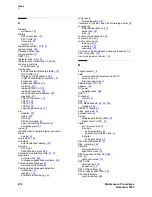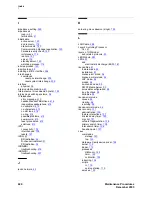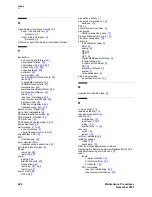
Additional maintenance procedures
Setting G700 synchronization
408
Maintenance Procedures
December 2003
ATMS measurement analysis
ATMS compares the results of the test measurements with threshold values to identify trunks that are out
of tolerance or unusable. Once a defective circuit has been pinpointed, a proper analysis must be made to
determine the appropriate action to take on the facility failures. Although there is no “right” procedure
for every situation, the following items will help in troubleshooting problems:
•
If a circuit fails an ATMS transmission test, it does not necessarily mean the trouble is in the
facility itself. The problem could be caused by a faulty test line, bad switch path, or a variety of
other reasons.
•
If a circuit fails a transmission test but successfully passes a supervision test, some of the items
mentioned above are probably not at fault, since proper call routing and circuit continuity are
required for successful of a supervision test.
•
If several circuits in the same group are failing, this could indicate the failure of some common
equipment (such as a carrier system, test line, or cable) or erroneous information in the threshold
tables.
•
When a test call can be successfully made, but not completed, either the OTL or TTL is probably
defective. For this failure type, further ATMS testing might be seriously impaired, but the system
is not otherwise affected.
•
If a test call cannot be successfully made, the wrong number might have been dialed, the far-end
device might be busy, the far-end device is defective, or there is a serious trunk failure obstructing
the call.
Setting G700 synchronization
If the Avaya G700 Media Gateway contains an MM710 T1/E1 Media Module, it is usually advisable to
set the MM710 up as the primary synchronization source for the G700. In so doing, clock sync signals
from the Central Office (CO) are used by the MM710 to synchronize all operations of the G700. If no
MM710 is present, it is not necessary to set synchronization.
If Communication Manager is running on an Avaya S8300 Media Server, however, the usual SAT screens
for “display sync” and “change sync” are not present. Clock synchronization is set via the Media
Gateway Processor (MGP) command line interface (CLI). The command (in configure mode) set sync
interface {primary | secondary} {<mmID> | [<portID>]} defines a potential stratum clock source
(T1/E1 Media Module, ISDN-BRI).,
where <mmID> is the Media Module ID of an MM stratum clock source of the form “vn”, where “n is
the MM slot number, and
For the MM720 BRI Media Module, <portID> is formed by combining the mmID of the MM to the 2-
digit port number of the BRI port.
By setting the clock source to primary, normal failover will occur. Setting the source to secondary
overrides normal failover, generates a trap, and asserts a fault. The identity of the current sync source in
use is not stored in persistent storage. Persistent storage is used to preserve the parameters set by this
command.
Содержание CMC1
Страница 1: ...Maintenance Procedures 555 245 103 Issue 1 1 December 2003 ...
Страница 14: ...Contents 14 Maintenance Procedures December 2003 ...
Страница 158: ...Server initialization recovery and resets System resets 158 Maintenance Procedures December 2003 ...
Страница 416: ...Additional maintenance procedures IP Telephones 416 Maintenance Procedures December 2003 ...
Страница 426: ...Index X 426 Maintenance Procedures December 2003 ...
















































